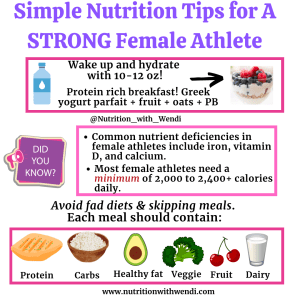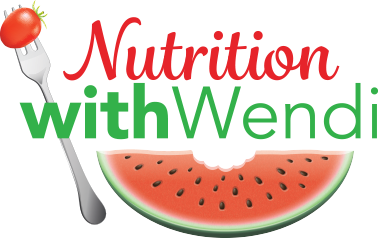
Amenorrhea & Athletes: 3 Tips For Females to Get Their Period Back
Relative energy deficiency in sport (RED-S) is the consequence of low-energy availability (LEA) in athletes, adversely affecting an athletes’ performance and health. RED-S can occur in both males and females, negatively impacting normal growth and development, hormonal health, bone health, ability to recover, strength and endurance, and even mental health. The Female Athlete Triad refers to a cluster of three RED-S symptoms originally identified in females, including low energy intake, menstrual disruptions, and low bone mineral density (BMD). It is imperative to prevent the Female Athlete Triad before it spirals into severe interruptions with bone strength, performance, long-term health, and fertility.
What is Low Energy Intake (LEA) and how does it occur?
- LEA can be intentional or unintentional, occurring when an athlete consumes fewer calories than her body requires for growth, development, and athletic performance. LEA is often associated with ‘disordered eating’ and in severe cases can lead to an eating disorder.
- Menstrual cycle disruption is the most critical impact of LEA in females. When a female athlete stops getting her period for at least 3 months, this is referred to as ‘amenorrhea.’ Prolonged amenorrhea can negatively impact fertility and bone health.
- Many athletes choose to intentionally restrict or limit their intake in hopes of “improving performance”. This is especially common in runners and dancers, where the mentality “lighter is faster” is prevalent but extremely damaging.
- Some athletes may just be unsure of how many calories they should consume to meet the demands of their sport, leading to unintentional LEA. Many athletes eat enough calories to sustain basic hormone function but are not eating enough to fuel sport performance and recovery!
- The effects of LEA fall into two categories: sociocultural and physiological. Athletes are at a much higher risk for LEA from sociocultural factors, including social media, sport-specific body image stereotypes, and pressure from coaches, teammates, and themselves on looking a certain way. These can all provide a false belief that the athlete will have greater performance outcomes by fitting into these sociocultural standards.
- Inadequate nutrition intake, leading to LEA, is problematic because the athlete has insufficient energy to fuel the body. For example, if a female athlete only consumes 1,800 kcal per day but uses 3,500 kcal, she is consuming 1,700 kcal LESS than her body NEEDS! In this scenario, the athlete will not have enough energy, impairing performance, growth, and development; it also puts her at heightened risk for illness, injury, impaired fertility, or a life-threatening eating disorder.
- At-Risk Sports: cross-country, distance running, cross-country skiing, wrestling, rowing, gymnastics, figure skating, dance, and weight-class sports.
Important future considerations
- The long-term negative effects of amenorrhea can impact fertility as women age.
- Women need adequate calories to achieve enough of energy reserve to promote fertility.
- Women must have enough body fat to produce leptin for reproduction and proper functioning of the ovaries.
- Scientist Rose Frisch proposed a body fatness theory of fertility in which women need to have at least 17% body fat to menstruate and about 22% body fat for fertility.
Fill out our athlete assessment form HERE and we can reach out to you for a consultation with one of our registered dietitians and sports nutritionists to help you with a plan.
How does menstrual health impact bone health?
Physical activity, specifically resistance training can have a positive impact on bone development. However, in cases of the female athlete triad or low energy availability, BMD may be low. This low BMD can be attributed to low levels of the hormone, estrogen, which plays a crucial role in bone health! Further, with inadequate calorie intake, athletes may be missing significant micronutrients like vitamin D, calcium, and magnesium, which support strong bones. Low BMD can increase the risk of bone stress injuries, including stress reactions and stress fractures, as well as osteoporosis.
Pro Tip: Test, don’t guess! If you or your student-athlete have concerns about menstruation, bone health, and estrogen levels, reach out to a doctor for blood tests.
Recovery of a menstrual cycle takes time but is significant for overall health as well as injury prevention and athletic performance.
Three ways we help female athletes regain their period:
- Increased calories (eating in an energy surplus) for 3-6 months, with a focus on adequate healthy dietary fats and eating frequently (avoiding periods of fasting)
- Reducing training volume and permitting healthy weight gain
- Log nutrition and track period symptoms
We teach our athletes that all foods fit! Most athletes need upwards of 3,500 + kcal to support health, training, and recovery demands.Person first and athlete second. We must help female athletes develop a healthy relationship with food!

If you are a parent of a young female athlete or coach that works with female athletes be sure to refer out to a registered dietitian. Female athletes have special considerations and hormone health should always be a top priority. We have worked with several female runners and competitive athletes to regain their period. It is not normal to lose your cycle for several months. We can work with your program or athlete to regain their cycle via a custom nutrition plan and ongoing coaching.
Female athletes need 3-4 balanced meals coupled with 2-3 snacks on training days. You can’t race like a beast if you eat like a bird!
Have more questions? We have answers!
- If you are looking for a team talk or presentation fill out our contact form to set up a FREE 15-min call HERE. Check out our performance nutrition partnership HERE.
- Health and performance guidebook that has over 170 resources including meal plans and tip sheets HERE.
- Take our FREE health assessment to see if you’re a good fit for our family or student-athlete nutrition coaching programs. Click here
In good health, wellness, and performance,
Sophia, Brenna, and Wendi your NWW team!

What can hiring a sports nutritionist offer your program? Learn more here. Interested in signing up for the NEW and upcoming NWW newsletter? Click here to sign up!
The Nutrition with Wendi team utilizes evidence-based science to tailor nutrition programs for athletes to optimize performance, minimize health risks, and enhance recovery from training while focusing on injury prevention. We partner with parents, athletes, health professionals, and individuals and offer elite nutrition and health guidance for optimal athletic performance, injury, and disease reduction. We provide virtual services including telehealth but are based in Nashville, TN. Follow us on Twitter, Facebook, and Instagram for more nutrition information. Services booking here to consult with Wendi for a team talk or QA session.
Resources:
Cabre, H. E., Moore, S. R., Smith-Ryan, A. E., & Hackney, A. C. (2022). Relative Energy Deficiency in Sport (RED-S): Scientific, Clinical, and Practical Implications for the Female Athlete. Deutsche Zeitschrift fur Sportmedizin, 73(7), 225–234. https://doi.org/10.5960/dzsm.2022.546
Gimunová, M., Paulínyová, A., Bernaciková, M., & Paludo, A. C. (2022). The Prevalence of Menstrual Cycle Disorders in Female Athletes from Different Sports Disciplines: A Rapid Review. International journal of environmental research and public health, 19(21), 14243. https://doi.org/10.3390/ijerph192114243
Márquez, S., & Molinero, O. (2013). Energy availability, menstrual dysfunction and bone health in sports; an overview of the female athlete triad. Nutricion hospitalaria, 28(4), 1010–1017. https://doi.org/10.3305/nh.2013.28.4.6542
Sims, S. T., Kerksick, C. M., Smith-Ryan, A. E., Janse de Jonge, X. A. K., Hirsch, K. R., Arent, S. M., Hewlings, S. J., Kleiner, S. M., Bustillo, E., Tartar, J. L., Starratt, V. G., Kreider, R. B., Greenwalt, C., Rentería, L. I., Ormsbee, M. J., VanDusseldorp, T. A., Campbell, B. I., Kalman, D. S., & Antonio, J. (2023). International society of sports nutrition position stand: nutritional concerns of the female athlete. Journal of the International Society of Sports Nutrition, 20(1), 2204066. https://doi.org/10.1080/15502783.2023.2204066
U.S. Department of Health and Human Services. (2023, May 17). Bone mineral density tests: What the numbers mean. National Institute of Arthritis and Musculoskeletal and Skin Diseases. https://www.niams.nih.gov/health-topics/bone-mineral-density-tests-what-numbers-mean
von Rosen, P., Ekenros, L., Solli, G. S., Sandbakk, Ø., Holmberg, H. C., Hirschberg, A. L., & Fridén, C. (2022). Offered Support and Knowledge about the Menstrual Cycle in the Athletic Community: A Cross-Sectional Study of 1086 Female Athletes. International journal of environmental research and public health, 19(19), 11932. https://doi.org/10.3390/ijerph191911932
